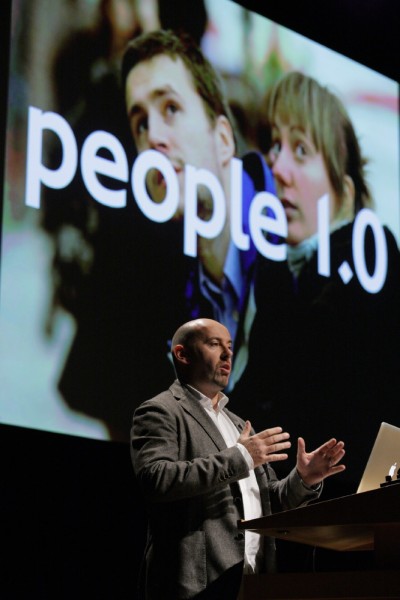So, instead, here is a 10 point summary of Tim’s fascinating 60 minutes.
1. We’re glad you’re here
Tim had been involved in a scooter accident the night before. He limped onto stage and didn’t make a fuss.
2. Look between the ears
Buidlings are buildings. They are beautiful or ugly. But they are there. The mind however is less easily fixed. If you start a system with the buildings you will create a system that relies on things we don’t care about. Having said that, despite London being a bit of an unholy mess when Tim and the team came to the project, only 3.7% of people looked at the signs that were already there; all 42 different varieties of them. So the first thing was to think about people and what makes them special.
3. Things should fit people
Generally speaking, we are a pretty slow species. We don’t catch on too quick. New fangled things can take some time to sink in. So however clever the things we invent are, we should always bear in mind that actual humans will be the final recipient, and that we have quirks, habits, and that we fear change. Never is this more true, or more important a consideration than when you are trying to guide people round a complex system, such as a city and its odd topography. So to understand human behaviour and learning is not a factor to consider, it is the first step you must take.
4. There are striders and strollersYou need the toilet, and you know where there is a toilet; you are a strider. You need a chocolate bar and you don’t really mind where or how quickly you buy it just as long as it’s your favourite type of chocolate bar; you are a stroller. And in between and outside these definitions reside hundreds of other permutations of moving states within the urban environment. Identifying, characterising and then designing your wayfinding system for all eventualities is a Herculean task.
5. Eureka on the pavement
Cities, in the eyes of man of those that use them every day, or visit them on holiday, are a collection of known spots sometimes only a little way apart, where you don’t really see the joins. Like the journey between Covent Garden and Leicester Square. When a pedestrian ventures that few yards further on – rather than take the train or a taxi – and sees how close these spots are in walking distance, there follows a eureka moment. And suddenly, the city seems more connected, and smaller, and more manageable.

Tim Fendley
6. Signs are funny
Not strictly true. Bad signs are funny. Until, that is, you have to make sense of one. Then they aren’t funny at all. Good signs are not funny. Tim’s system is not funny. Sorry Tim.
7. Parsimony
One of the key tasks in the development of a system like this is reaching a point of parsimony; finding the point where you have provided the optimum information to help the user achieve the desired task. This requires considerable user testing and a lot of human understanding. Its a grandiose way of saying that you have got things ‘just right’. Like making good gravy.
8. Filling in the gaps
Applied Information Group plotted the space between stations, as concentric circles, and saw that you didn’t have to walk too far between them to connect them. They also recalibrated London’s villages, so tha areas of the city re-adopted area names long since forgotten, making the city less daunting, and friendlier at a stroke. The gaps, or as described above – the space where the eureka moment takes place – were the things that Legible London helped join up, shaving minutes of commuting time, reducing the pressure on the Underground, and making the streets more familiar.
9. The engorged hippocampus
We all have one. It is a part of the brain that deals with mapping. It helps us piece together events that we slowly piece together to make navigation through spaces easier. In London, some cab drivers pass a test called The Knowledge. It demands of them an encyclopaedic knowledge of London’s streets and which clearly means their hippocampal operations are very finely tuned. This is why they can talk about other things as they take you smartly from A to Z (and why cabbies with a hippocampal ability like you or I take you from A to Z via G and W). So, considering we evolve slowly, but that we do have a mental muscle that can help compensate, a system that accounts for this will certainly have a greater chance of success.
10. The cognitive and the guidelined
What Applied Information Group have done is surely essential in their line of work, but ought be at the heart of all user focused design: it should be focused on, and driven by the user. Guidelines – such as they are required – can only energy from the needs and requirements of human beings, expected to make sense of and then utilise systems like Legible London. Too many of he examples shown by Tim were driven by a ring binder full of instructions, and as such displayed more allegiance to rules than to human behaviour.
That’s what Tim and his team expressly avoided.
What they have created is consistent of course, and in some ways, quite beautiful. Most importantly, it has thought about us first, and how it looks second. It sounds simple; it should be mandatory. In the case of Legible London it means the difference between developing ‘another’ wayfinding system, or actually creating the definitive one.
Text: Patrick Baglee











 Photo: Gerhard Kassner
Photo: Gerhard Kassner











Pingback: Fontblog | TYPO London 2011 im Rückblick